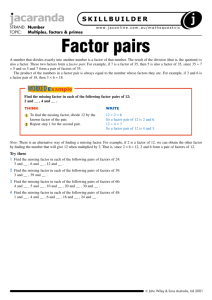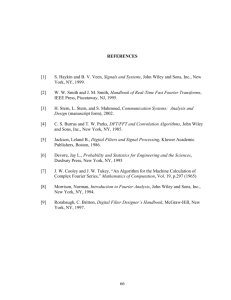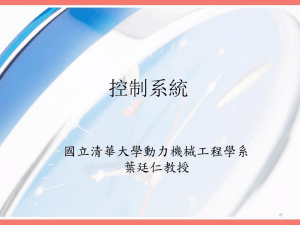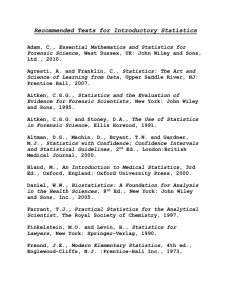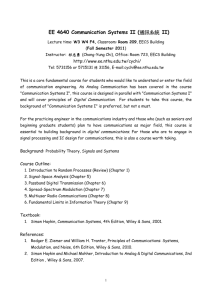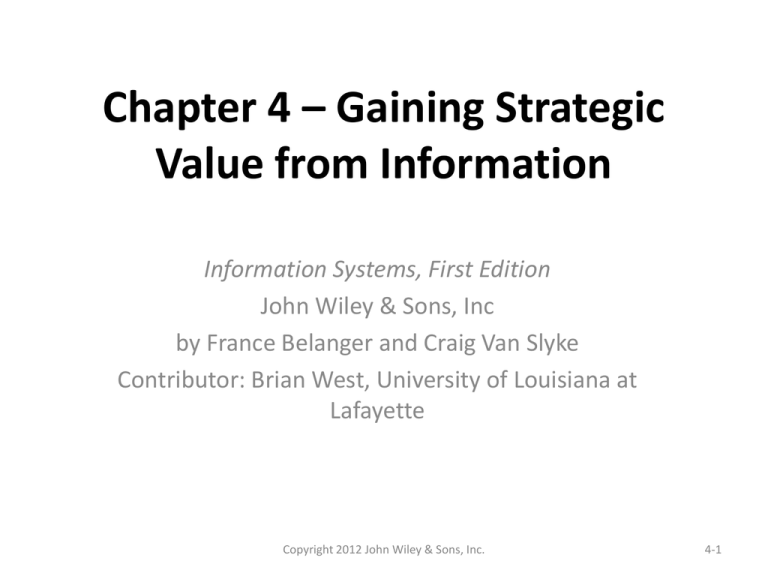
Chapter 4 – Gaining Strategic
Value from Information
Information Systems, First Edition
John Wiley & Sons, Inc
by France Belanger and Craig Van Slyke
Contributor: Brian West, University of Louisiana at
Lafayette
Copyright 2012 John Wiley & Sons, Inc.
4-1
Learning Objectives
• Present the main steps in the strategic
planning process.
• Identify competitive advantage frameworks
and discuss their purposes.
• Discuss methods for evaluating strategic
initiatives.
• Explain the concept of hyper-competition.
Copyright 2012 John Wiley & Sons, Inc.
4-2
Healthcare on My Cell Phone
It is often possible to also get competitive advantages from
creative uses of existing technologies. One of these exciting
newer trends in the world of medicine is mobile health, also
called mHealth.
Mobile health care services can include compliance (ensuring
that patients follow their medication plan), information
dissemination (providing caloric information for obesity or
sugar content for diabetes), or monitoring (measuring
hypertension, cholesterol, etc.), for example.
A survey by Pyramid Research (www.pyr.com) in December
2010 reveals that there are actually over 200 million mHealth
applications available today, and that 70% of individuals
around the world would be willing to pay for using at least
one such application
Copyright 2012 John Wiley & Sons, Inc.
4-3
Focusing Questions
• Identify other potential applications of
mHealth?
• Would you be more likely to follow a health
program if it was offered on your mobile
device?
• What are the benefits of mHealth for existing
health care organizations?
Copyright 2012 John Wiley & Sons, Inc.
4-4
Strategic Information Systems
• Today, organizations need a wide variety of information
systems for conducting their day-to-day business.
• For example, some information systems can be used
for basic accounting services, such as payroll systems,
or for communication support services, like electronic
mail.
• We are interested in those information systems that
are more specifically meant to provide organizations
with competitive advantages.
• We call those business initiatives strategic information
systems.
Copyright 2012 John Wiley & Sons, Inc.
4-5
Strategic Planning Process
• The identification of strategic information
systems should follow a structured set of
steps, or planning process.
• The goal of the strategic planning effort is to
identify how the organization will use and
manage their resources for strategic purposes
(think competitive advantage).
Copyright 2012 John Wiley & Sons, Inc.
4-6
Strategic Planning Process
Notice how the process is iterative, with later
steps in the process requiring managers to
revisit earlier steps.
Strategic
Business
Planning
Information
Systems
Assessment
Information
Systems
Vision
Information
Systems
Architecture
Strategic
Initiatives
Identification
Figure 4.1 Information Systems Strategic Planning Process
Copyright 2012 John Wiley & Sons, Inc.
4-7
Step 1:
“Know Who You Are.”
• Before an organization can decide what IT initiatives
can be used to gain competitive advantage, it has to
clearly identify what the mission of the organization is,
and how it is going to achieve this mission.
• Should be performed on a regular basis by the
executives or leaders of the organization
• Outcomes should include the mission and vision of the
organization, its goals for the future, and the strategies
that will be used to achieve those goals.
Copyright 2012 John Wiley & Sons, Inc.
4-8
Step 1:
• Strategic business planning is not specifically
focused on information systems
• It is essential to the IS strategic planning
process because the organization needs
• The goal is to achieve a high level of alignment
between the business side of the organization
and its information systems
Copyright 2012 John Wiley & Sons, Inc.
4-9
Step 2:
“Know where you start”
• Identify the current state of information
systems resources in the organization
• Conduct a proper assessment of resources
because these resources could enable
information systems managers to meet or
surpass some strategic objectives
• Lack of certain resources may constrain what
an organization can achieve
Copyright 2012 John Wiley & Sons, Inc.
4-10
Step 2:
There are three categories of resources:
• Technical resources, which include hardware,
software, and networks
• Data and information resources, such as
databases
• Human resources, which would include the
skills and personal characteristics of the
information systems employees, the user
community
Copyright 2012 John Wiley & Sons, Inc.
4-11
Step 3:
“Know Where They Want To Go”
• Given those statements and the IS resources
identified in the second phase, information
systems managers must now develop a vision
specifically for IS
• The senior information systems person in the
organization must gather not only employees of
the information systems group, including
individuals with technical skills, but also
functional managers
Copyright 2012 John Wiley & Sons, Inc.
4-12
Step 3:
• The IS vision should be a broad statement of how
the organization should use and manage its
information systems for strategic purposes
• The IS vision has to be aligned with the
organization’s mission, vision, and strategies,
which may require revisiting the organization’s
strategies
• The statement should define what the role that
information systems should be for the
organization.
Copyright 2012 John Wiley & Sons, Inc.
4-13
Step 4:
“Know How You Are Going To Get There”
• The selected information systems architecture will provide
some guidelines for future uses, acquisitions, and the
management of information resources.
• Architectural guidelines could include statements about all
information resources including
– hardware,
– software
– networks
• It should also include way data is stored, protected, and
managed, and how information systems human resources
are managed, such as whether information systems work
can be outsourced.
Copyright 2012 John Wiley & Sons, Inc.
4-14
Step 5:
• The ultimate goal of the information systems
strategic planning process is to identify strategic
information systems initiatives that will provide
competitive advantages to the organization.
• These initiatives tend to be longer term (two to
five years) but some strategic initiatives can be
launched rapidly.
• Strategic initiatives can be about systems, but
most of the time involve much more than
technology, which may result in a new strategic
direction for the organization.
Copyright 2012 John Wiley & Sons, Inc.
4-15
Advantages of IS Strategic Planning
Process
•
– Providing documented discussions of the advantages
and disadvantages of each initiative, overall
communication inside the organization is improved.
•
– The improved overall coordination of the efforts
related to the initiative, both before and during the
implementation.
•
– Decision making is more consistent over time with
respect to which strategic initiatives are supported
and more importantly, why.
Copyright 2012 John Wiley & Sons, Inc.
4-16
Frameworks for Strategic Information
Systems
Tools that can be used to identify strategic
information systems initiatives
•
•
•
•
Copyright 2012 John Wiley & Sons, Inc.
4-17
Information Systems SWOT Analysis
SWOT (Strengths, Weaknesses, Opportunities,
and Threats)
Component
Description
Example for Amazon.com
Strengths
Leadership position in online retailing
Weaknesses
Increased size of the company requires
more investments
Opportunities
Expand to services instead of just retailing
Threats
Increasing global competition from online
retailers
Table 4.1 SWOT Analysis Components
Copyright 2012 John Wiley & Sons, Inc.
4-18
Porter’s Five Competitive Forces
Model
Analyze how competitive an industry is and
therefore determine if a particular market could
be attractive for an organization to consider.
Potential
Threat of
New
Entrants
Bargaining
Power of
Buyers
Industry
Competitive
Rivalry
Bargaining
Power of
Suppliers
Potential
Threat of
Substitutes
Figure 4.2 Porter’s Five Competitive Forces Model
Copyright 2012 John Wiley & Sons, Inc.
4-19
Porter’s Five Competitive Forces
Model
Competitive Force
Description
Potential Threat
of New Entrants
Bargaining Power
of Buyers
Desired Level
Strategic Information
Systems
Examples
How easy is it for new
companies to enter the
market in which the
organization operates.
How could you use
information systems to
increase barriers to entry
in the organization’s
market?
Create barriers to entry - leverage
data about customers that others
cannot access, creating information
asymmetry.
What is the ability (or
market power) of the
organization’s buyers
(customers) to reduce its
competitive position (e.g.,
by bringing prices down).
How could you use
information systems to
reduce the power of
negotiation of buyers?
Create switching costs – give
customers value added services
such as personalization or lower
costs (through economies of scale)
that will make them loyal to the
organization.
Table 4.2 Porter’s Five Competitive Forces Model and Strategic Information Systems
Copyright 2012 John Wiley & Sons, Inc.
4-20
Porter’s Five Competitive Forces
Model
Competitive
Force
Strategic Information
Systems
Examples
What is the ability (or market
power) of the organization’s
suppliers to reduce its
competitive position (e.g., by
bringing prices up).
How could you use
information systems to reduce
the power of negotiation of
suppliers?
When there are few suppliers, this tends to
be a high barrier. Use information systems
to aggregate buying power with others (for
example, online exchanges) or reduce the
cost of buying (electronic procurement).
Potential Threat of
Substitutes
What is the likelihood that other
products of equal of superior
value will be available?
How could you use
information systems to make
your products unique or make
customers unwilling to use
substitutes?
Create switching costs so customers will not
be willing to use substitutes
(personalization, lower costs, etc.) or use
information systems to create unique or
patented products such as proprietary
systems (like Google applications or Apple
products).
Industry Competitive
Rivalry
What is the current level of
competition in the industry?
How could you use
information systems to ensure
that competition is limited in
the industry?
Use information systems to differentiate the
organization’s products so that there are
few or no competitors.
Bargaining Power of
Suppliers
Description
Desired Level
Table 4.2 Porter’s Five Competitive Forces Model and Strategic Information Systems
Copyright 2012 John Wiley & Sons, Inc.
4-21
Porter’s Value Chain
• Managers identify all of the activities that the
organization must perform to conduct its
business
• Two broad categories of activities in the value
chain, primary and support.
– _______ activities are directly related to the creation,
processing or delivery of the product or service.
– ________ activities are those overall tasks that make
it possible for the organization to function, but that
are not directly involved in the product or service.
Copyright 2012 John Wiley & Sons, Inc.
4-22
Porter’s Value Chain
Primary
Activities
Support
Activities
Inbound
Logistics
Manufacturing
Assembly
Outbound
Logistics
Marketing
and Sales
Service
Human Resources
Information Technology
Administrative Support
Procurement
Figure 4.3 Porter’s Value Chain in Manufacturing Firm
Copyright 2012 John Wiley & Sons, Inc.
4-23
Porter’s Value Chain
• Porter identified two major ways to create
competitive advantages in the value chain
– lower the costs of performing an activity
– add more value to the final products and services
in an activity
• Managers can ask themselves for every
activity in their value chain
–
–
Copyright 2012 John Wiley & Sons, Inc.
4-24
Virtual Value Chain
The virtual value chain looks at activities that
turn raw data into useful information
• What ways can information systems make
gathering, organization, selecting, synthesizing
and distributing less expensive
• How can more value can be added to the
firm’s information using information systems
Copyright 2012 John Wiley & Sons, Inc.
4-25
Virtual Value Chain
Telecommunications
Gathering
Data &
Information
Legal Department
Organizing
Data &
Information
Personnel
Selecting
Information
Accounting
Synthesizing
Information
Distributing
Information
Figure 4.4 Virtual Value Chain: Handling Information
Copyright 2012 John Wiley & Sons, Inc.
4-26
Evaluating Strategic Initiatives
• Not all Strategic initiatives are doable (for
example requiring technology that does not
exist yet), and others are not worth doing (for
example, too costly with limited benefits)
• We therefore need to rank the initiatives, or at
least eliminate those that cannot or should
not be considered.
–
–
Copyright 2012 John Wiley & Sons, Inc.
4-27
Critical Success Factors
Critical success factors (CSF) are those few
important considerations that must be achieved
for the organization to survive and be successful.
• These are not about technology (in general),
but more about business objectives
• CSFs must be in line with the organization’s
vision and mission
• Organizations usually should have just a few
critical success factors
Copyright 2012 John Wiley & Sons, Inc.
4-28
Critical Success Factors
The key questions asked to start the discussion
are similar to these
• What needs to happen for our organization to
increase its revenues?
• What are the most important actions we
need to take to be more competitive?
• What is needed for us to be more successful?
Copyright 2012 John Wiley & Sons, Inc.
4-29
What does Yahoo need for success?
The purpose of the activity is to get some
practice identifying critical success factors. Your
instructor will assign you to groups, and each
group of student will act as a top management
team from the company Yahoo! Your job is to
brainstorm critical success factors for the
company.
Copyright 2012 John Wiley & Sons, Inc.
4-30
Priority Matrix
The priority matrix allows managers to evaluate
potential initiatives and prioritize them along
two key dimensions
• ease of implementation
– costs, time required, efforts required, or the
actual complexity of the system
• Potential returns
– revenues, market shares, savings, reputation
Copyright 2012 John Wiley & Sons, Inc.
4-31
Priority Matrix
Potential Returns (Revenues, market, etc.)
High
Low
Initiative
5
Evaluate
Initiative
3
Imperatives
Initiative
1
Initiative
4
Initiative
2
Stay Away
Quick Wins
Ease of Implementation (Low cost, effort, etc.)
High
Figure 4.5 Sample Priority Matrix
Copyright 2012 John Wiley & Sons, Inc.
4-32
Priority Matrix
• __________ are initiatives that should be
relatively easy to implement
• __________ represent initiatives that do not have
much upside potential but are easy to implement
• __________ quadrant needs to be discussed and
evaluated thoroughly by managers
• __________ quadrant includes what many say
are lost causes, initiatives that would be difficult
to implement with limited potential returns
Copyright 2012 John Wiley & Sons, Inc.
4-33
Competitive Advantage at Outrigger
Hotels and Resorts
This activity requires you to complete a
competitive analysis of Outrigger Hotels and
Resorts (Piccoli, 2005). Use one of the
frameworks we discussed to
• Identify the competitive position of Outrigger
Hotels and Resorts
• Identify three strategic information systems
initiatives you believe the company should
consider.
Copyright 2012 John Wiley & Sons, Inc.
4-34
Hyper-competition: Sustainability of
Competitive Advantage
• Some individuals to question how sustainable
is any competitive advantage a firm obtains
through its initiatives.
• This is the concept of hyper-competition.
• D’Avenis suggests that organizations should
seek to create disruptions in the market
through a series of initiatives.
Copyright 2012 John Wiley & Sons, Inc.
4-35
D’Avenis’ 7Ss
Superior stakeholder satisfaction
Maximizing customer satisfaction by adding value strategically.
Strategic soothsaying
Positioning for speed
Positioning for surprise
Shifting the rules of competition
Signaling strategic intent
Simultaneous and sequential strategic thrusts
Table 4.3 D’Avenis’ 7Ss
Copyright 2012 John Wiley & Sons, Inc.
4-36
Google vs. Yahoo
Your team is tasked with selecting one of the 7Ss
from the D’Aveni’s framework, specifically targeted
at finding a way for Yahoo! to better compete with
Google.
• The team must then identify a specific strategic
initiative that will be used to implement the
selected strategy.
• Once this activity is completed, all initiatives
proposed by the groups in the class should be
prioritized using the Critical Success Factors
Copyright 2012 John Wiley & Sons, Inc.
4-37
Summary
• There are five main steps in the strategic planning
process
• We discussed four frameworks that can be used to
identify strategic information systems initiatives
• We discussed two methods for evaluating strategic
initiatives: the Critical Success Factors method, and the
Priority Matrix.
• Hyper-competition is when competitive advantages are
rapidly eroded by competitors so that organizations
should focus on market disruptions instead of trying to
sustain competitive advantages.
Copyright 2012 John Wiley & Sons, Inc.
4-38
Copyright 2012 John Wiley & Sons, Inc.
All rights reserved. Reproduction or translation of this
work beyond that permitted in section 117 of the 1976
United States Copyright Act without express permission
of the copyright owner is unlawful. Request for further
information should be addressed to the Permissions
Department, John Wiley & Sons, Inc. The purchaser may
make back-up copies for his/her own use only and not for
distribution or resale. The Publisher assumes no
responsibility for errors, omissions, or damages caused by
the use of these programs or from the use of the
information herein.
Copyright 2012 John Wiley & Sons, Inc.
4-39

